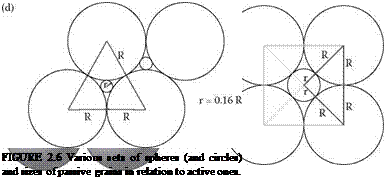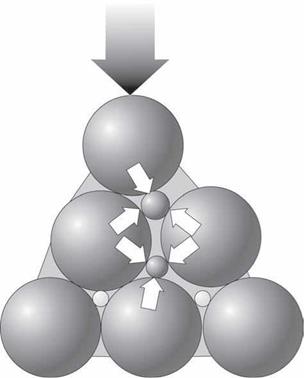Definition of an sma skeleton with other methods
In some countries (e. g., the United States and the Netherlands) a method of constructing an SMA skeleton has been developed based on the control of stone-to-stone contact or a real gradation discontinuity. Based on these methods, the definition of SMA is expanded to mean an asphalt mixture containing mastic stabilizer (drainage inhibitor) with a gap-graded aggregate blend and a very high content of coarse aggregates in which smaller grains are seated among the bigger ones, filling voids among them but not shoving them aside. Based on this definition of SMA, it is necessary to determine the level of gradation discontinuity at which active grains are not shoved aside by passive ones.
Let us look at Figure 2.6a to d, which shows an idealized arrangement of grains (represented by smooth spheres) in an aggregate blend and illustrates the relationships between the radii of the active coarse grains (marked R) that form the skeleton and the radii of the passive fine grains (marked r). The proportions of the different grain sizes have been selected so that the smaller grains do not shove the bigger ones aside.
Thus we have two sets of spheres, here being examined two-dimensionally. Now we may theorize a bit on their significance for the sought-after discontinuity. [4]
 |
• Such an arrangement of grains as shown in Figure 2.6a and b is unnatural and unlikely. The one presented in Figure 2.6c and d is more likely. But it is easy to see that one consequence of a better (closer) distribution of coarse grains is the reduction of free space available for filling (passive) aggregate. Simple geometric analysis enables the calculation of the maximum dimension of fine grains, equal to 0.16 R, to avoid shoving coarse grains aside in this scenario. If we look again at the example of the SMA 0/12 mm, apart from the active 8/12 mm fraction, the next material will be just the passive 0/2 mm (sand) fraction.* In the arrangement illustrated in Figure 2.6c and d, the necessary gradation discontinuity would consist of the absence of the 2/8 mm fraction.
These deliberations have been carried out on the assumption that the only active fraction is the 8/12 mm one, but this is by no means obvious. The SMA skeleton may also involve active grains smaller than the 8/12 mm fraction, such as grains bigger than 5 mm. Active grains of the 8/12 mm and 5/8 mm fractions would have a considerable influence on the formed skeleton owing to the following: [5]
• Better packing of coarse grains (here, larger than 5 mm)
• Reduction of the size of voids and therefore the size of the filling grains
If the 5/8 mm fraction is also active, the desired grain discontinuity may be secured by the absence of the 2/5 mm fraction. The Bailey method, described in detail in Chapter 7, is based on a similar geometric calculation; that approach assumes that each successive aggregate fraction should be equal to about 1/5 (0.22) of the larger fraction. This requirement is intended to prevent smaller particles from shoving the coarse aggregate skeleton aside. As we can see, the path from geometry to design method is not a long one.
These considerations are only theoretical because in a real mixture we do not deal with balls and the layout of grains is different. Yet those examples point out a significant issue; interfering with the gradation discontinuity (by adding aggregates of that size fraction) causes the loss of stone-to-stone contact of the coarse grains that form the SMA skeleton (Figure 2.7). This conclusion forms the basis of the U. S. method of SMA design and the so-called Bailey method (both presented in Chapter 7). The same conclusion has also been used in some Scandinavian solutions (e. g., in the real SMA concept).
|
FIGURE 2.7 Interrupted discontinuity of gradation occurs when the presence of the inbetween size grains disturb the action of the coarse aggregate skeleton. |
A final remark—looking at Figure 2.4, we may be inclined to make a mixture of only one size fraction of coarse aggregate (8/12 mm) with mastic (0/2 mm). Obviously we would get a very strong aggregate skeleton, but we cannot forget the following technological consequences:
• Placement would be difficult; the coarse grains might be pulled by the screed plate.
• Compaction would be complicated; such a mixture is difficult to compact.
• We may have difficulty keeping the void content below 6% (v/v)* in the compacted surface course.
These reasons demonstrate the need for smaller, but still coarse, grains to participate in forming the skeleton. Further discussion on the features of such a mixture and analysis of the influence of the coarse aggregate gradation will be found in Chapter 6.







Leave a reply